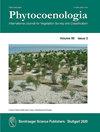Plant communities partially refl ect environmental gradients in humanized landscapes: a case study in the Llobregat delta marshes
IF 0.9
4区 生物学
Q4 ECOLOGY
引用次数: 1
Abstract
This study took place in a vegetation mosaic of the Llobregat delta (near Barcelona, Spain), which includes both natural and spontaneously restored coastal marshes. We used a dataset comprising vegetation relevés, soil parameters and water table conditions, and explored their correlation. More precisely, we classifi ed the relevés into three phytosociological alliances (namely Phragmition communis, Salicornion fruticosae and Juncion maritimi) combining the previous information available and the use of PCA ordinations. We studied whether these alliances refl ect the main operating environmental gradients (conductivity, sodium absorption rate and water table dynamics) using a GLMM (generalized linear mixed model). The PCA refl ected a fair distinctiveness of Salicornion and Phragmition, whereas Juncion was a more heterogeneous unit, related to the varying dominance of different plant species. The three alliances exhibited signifi cant differences in environmental variables and therefore the phytosociological ordination refl ected at least partially the main operating environmental gradients. However the assemblage of alliances over the gradients varied between locations, suggesting that the initial species pool or plant dispersal capacity to some extent shapes the dynamics of spontaneous restoration in these marshlands.植物群落在一定程度上反映了人文景观中的环境梯度:以略布列加特三角洲湿地为例
这项研究在略布里加特三角洲(西班牙巴塞罗那附近)的植被马赛克中进行,其中包括自然和自发恢复的沿海沼泽。我们使用了包含植被相关数据、土壤参数和地下水位条件的数据集,并探讨了它们之间的相关性。结合以往的资料和PCA排序,我们将相关的芸苔虫分类为三个植物社会学联盟(Phragmition communis, Salicornion fruticosae和Juncion maritimi)。我们使用GLMM(广义线性混合模型)研究了这些联盟是否反映了主要的操作环境梯度(电导率、钠吸收率和地下水位动态)。主成分分析反映了Salicornion和Phragmition的显著性,而Juncion则是一个异质性较强的单位,与不同植物种类的优势度变化有关。三个联盟在环境变量上存在显著差异,因此植物社会学协调至少部分反映了主要的运行环境梯度。然而,不同地点的梯度上的联盟组合不同,这表明初始物种库或植物扩散能力在一定程度上决定了这些湿地的自发恢复动态。
本文章由计算机程序翻译,如有差异,请以英文原文为准。
求助全文
约1分钟内获得全文
求助全文
来源期刊

Phytocoenologia
生物-植物科学
CiteScore
2.60
自引率
0.00%
发文量
7
审稿时长
>12 weeks
期刊介绍:
Phytocoenologia is an international, peer-reviewed journal of plant community ecology. It is devoted to vegetation survey and classification at any organizational and spatial scale and without restriction to certain methodological approaches. The journal publishes original papers that develop new vegetation typologies as well as applied studies that use such typologies, for example, in vegetation mapping, ecosystem modelling, nature conservation, land use management or monitoring. Particularly encouraged are methodological studies that design and compare tools for vegetation classification and mapping, such as algorithms, databases and nomenclatural principles. Papers dealing with conceptual and theoretical bases of vegetation survey and classification are also welcome. While large-scale studies are preferred, regional studies will be considered when filling important knowledge gaps or presenting new methods.
 求助内容:
求助内容: 应助结果提醒方式:
应助结果提醒方式:


